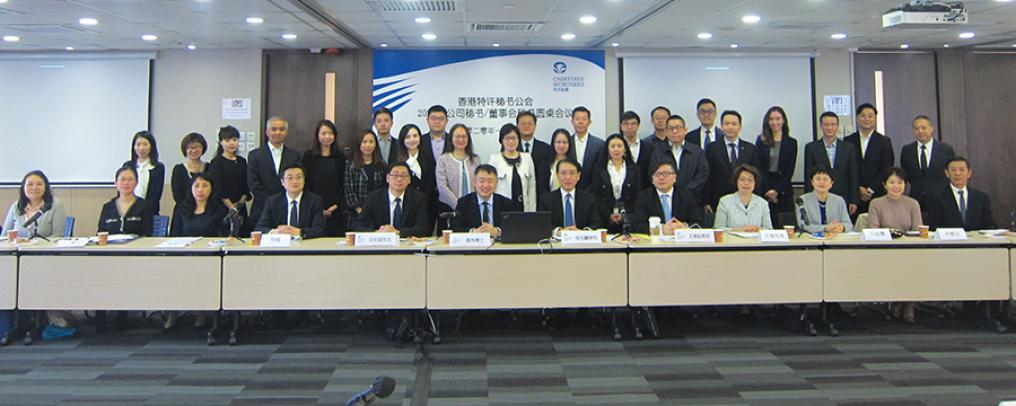
Inside information disclosure in Hong Kong and the Mainland – A comparison of the A+H share information disclosure requirements
PH Chik, Solicitor and Legal Adviser to the Mainland China Technical Consultation Panel of The Hong Kong Institute of Chartered Secretaries (the Institute), completes his two-part article in CSj looking at the major similarities and differences between the inside information and material information disclosure law and regulations in Hong Kong and the Mainland.
The first part of this article, published in last month’s CSj, gave an introduction to the statutory disclosure requirements and the applicable rules of the relevant stock exchanges (referred to as the ‘Hong Kong rules’ and ‘the Mainland rules’ respectively) in Hong Kong and the Mainland. This second part of the article will look at some further issues relevant to the Hong Kong rules and the Mainland rules and discusses some practical issues that A+H listed companies may encounter on information disclosure.
1. Safe harbours
Safe harbours (Hong Kong)
The Hong Kong safe harbour provisions allow:
- non-disclosure, if the disclosure is prohibited under or would contravene an order of a Hong Kong court or a Hong Kong law (Section 307D(1), Securities and Futures Ordinance (SFO)), and
- delayed disclosure, if and so long as the listed issuer takes reasonable precautions to preserve confidentiality and the confidentiality is preserved, if the information:
- concerns an incomplete proposal or negotiation
- is a trade secret
- concerns the provision of liquidity support from the Exchange Fund, or
- the disclosure is waived by the Securities and Futures Commission (SFC) (Section 307D(2), SFO).
Subject to conditions, a waiver from disclosure may be granted by the SFC if disclosure is prevented by or would constitute a contravention of the law, a court order or restriction imposed by a law enforcement agency or government authority outside Hong Kong (Section 307E(1), SFO).
To rely on a safe harbour exemption, a listed issuer must take reasonable measures to preserve confidentiality of the information and ensure that the confidentiality is preserved (see Section 3 below, ‘Reasonable confidentiality measures’).
Disclosure ‘as soon as reasonably practicable’ is required after the listed issuer becomes aware that the confidentiality of the information has not been preserved (Section 307D(4)(b), SFO).
Safe harbours (the Mainland)
Just as in Hong Kong, the Mainland rules allow non-disclosure or delayed disclosure.
- Delayed disclosure is allowed in circumstances where:
- there is uncertainty in the information to be disclosed
- a temporary business secret is involved, or
- timely disclosure may be detrimental to the listed issuer or mislead investors (Rule 5, Guidelines for Temporary Non-disclosure of Information and Exemption from Information Disclosure of the Shanghai Stock Exchange (上市公司信息披露暂缓与豁免业务指引) (the Shanghai Non-disclosure Guidelines)).
Non-disclosure applies to the following circumstances:
- a business secret or state secret is involved, or
- disclosure in accordance with the listing rules is likely to be in breach of the state confidentiality laws or may be detrimental to the interest of the listed issuer and mislead investors (Rule 6, Shanghai Non-disclosure Guidelines).
Both non-disclosure and delayed disclosure are subject to the provisions that:
- the information remains confidential without leakage
- the insiders have provided confidential undertakings in writing, and
- there is no unusual movement in the company’s share price (Rule 8, Shanghai Non-disclosure Guidelines).
Preserving confidentiality is a ground for delayed disclosure (Rule 9, Shanghai Non-disclosure Guidelines). No application to the relevant stock exchange is required for delayed disclosure and non-disclosure, but the Mainland rules require the listed issuer to make a record of the decision not to disclose (Rule 9, Shanghai Non-disclosure Guidelines). Also, insiders are required to keep ‘inside information’ (for the purpose of prohibition against insider dealing) confidential before disclosure (Rule 4, Rules Governing Listing Companies’ Establishment of a Registration System for Person with Knowledge of Inside Information (關於上市公司建立內幕信息知情人登記管理制度的規定) (the PRC Rules on Insider Registration System)). The Mainland rules also contain elaborate provisions relating to the management of inside information (see Section 3 below, ‘Reasonable confidentiality measures’).
However, timely disclosure will be required if:
- there is leakage or market rumour relating to the event, or
- reasons for non-disclosure have been eliminated or the applicable exemption period has expired (Rule 10, Shanghai Non-disclosure Guidelines).
Commentary
The Mainland and Hong Kong rules on safe harbours are quite similar except the areas set out below.
- The Mainland rules allow for both delayed disclosure and non-disclosure of information which may be detrimental to the interests of the listed issuer or may mislead investors. There is no similar provision in the Hong Kong rules and may not be a ground for grant of waiver by the SFC.
- Under the Mainland rules, a business secret can be a temporary business secret. A temporary business secret can be temporarily withheld from disclosure whereas a business secret is exempt from disclosure. However, a trade secret enjoys only delayed disclosure in Hong Kong.
- A state secret is exempt from disclosure under the Mainland rules, but the same state secret may only be withheld from disclosure in Hong Kong if a waiver is granted by the SFC.
Preservation of confidentiality is required under both the Mainland and the Hong Kong rules for non-disclosure or delayed disclosure. Under both sets of rules, if confidentiality cannot be kept or information has been leaked, disclosure as soon as reasonably practicable is required.
2. Responsibility for compliance and controls
Listed issuer and officer’s responsibilities (Hong Kong)
In Hong Kong, while a listed issuer must disclose inside information, it is the responsibility of its every officer to take reasonable measures from time to time to ensure compliance with the disclosure requirements (Section 307G(1), SFO). If a listed issuer is in breach of a disclosure requirement, an officer who has not taken all reasonable measures to prevent the breach is also in breach of the disclosure requirement (Section 307G(2)(b), SFO). Alternatively, he/she will be liable if his/her intentional, reckless or negligent conduct has resulted in the breach (Section 307G(2)(a), SFO).
For example, the Market Misconduct Tribunal in Hong Kong, in its inquiries into whether a breach of the disclosure requirements had taken place in relation to the securities of Mayer Holdings Ltd, found that the listed issuer had no written internal policies on information disclosure and that the relevant officers had failed to take any reasonable measure to ensure proper safeguards exist to prevent a breach by the listed issuer of the disclosure requirements. (Paragraph 121, Market Misconduct Tribunal Report on Mayer Holdings Ltd dated 7 February 2017). The relevant officers were liable for breach of the disclosure requirements.
‘Officer’ means a director, manager or company secretary of, or any other person involved in the management of, the listed company (Part 1, Schedule 1, SFO). A ‘manager’ is a person who, under the immediate authority of the board, is charged with management responsibility affecting the whole listed issuer or a substantial part of the listed issuer. A person is normally regarded as being ‘involved in the management of the corporation’ if the person discharges the role of a ‘manager’. A company secretary is an ‘officer’ of a listed company for the purpose of disclosure of inside information (Paragraph 53, SFC’s Disclosure Guidelines).
Reasonable disclosure measures (Hong Kong)
The SFC’s Disclosure Guidelines provide examples of reasonable measures, which include, among other things, the following (Paragraph 60, SFC’s Disclosure Guidelines):
- monitor business and corporate development to identify potential inside information; periodic financial reporting to identify key operating data (see also Paragraph 55, SFC’s Disclosure Guidelines)
- authorise one or more officer(s) or an internal committee to evaluate potential inside information and to consider whether to escalate any such information to the board
- develop procedures to handle rumours, leaks and inadvertent disclosures
- designate one or two officer(s) to deal with the media, analysts or investors
- establish procedures for prior review of presentation materials before release
- provide regular training to employees on the disclosure policy, and
- document the disclosure policy and make such policy available to the public.
The SFC also provides specific guidance on dealing with particular situations and issues, such as media speculation, market rumours, analysts’ reports, publication by third parties, external developments, and so on (see ‘Guidance on particular situations and issues’ in the SFC’s Disclosure Guidelines) and expects a listed issuer to set up its own internal guidelines to handle disclosure in these situations.
Listed issuer and other’s responsibilities (the Mainland)
Under the Mainland rules, a listed company shall establish and implement rules for the management of information disclosure (Article 37, Disclosure Administrative Measures and Rule 2.10, Shanghai Listing Rules). The board of directors shall be responsible for the establishment of such rules and shall evaluate annually the implementation of such rules and rectify such rules, if required.
The chairman or chief executive shall assume primary responsibility for the implementation of such rules. The supervisory committee shall be responsible for supervision of the implementation of such rules (Articles 7 to 11, Guidelines of Shanghai Stock Exchange for the Information Disclosure Management Measures of Listed Companies (上市公司信息披露事務管理制度指引) (the Shanghai Information Disclosure Management Measures)).
Disclosure measures (the Mainland)
Under the Mainland rules, the duties of the issuer, its directors and board secretary on information disclosure are as follows:
- the issuer: to ensure that no inside information is disclosed when communicating information relating to its operations, financial profile and other events in a results meeting, analysts meeting, roadshow or other investors meeting (Article 41, Shanghai Disclosure Administrative Measures)
- the directors: to keep track of the listed company’s operations, financial status, major events which have occurred or may possibly occur; should also take initiatives to check and obtain the information necessary in deciding whether to disclose (Article 42, Shanghai Disclosure Administrative Measures)
- the board secretary: to be responsible for handling matters relating to external disclosure of information by the listed company (Article 45, Shanghai Disclosure Administrative Measures), and
- unless authorised in writing, no directors, supervisors or senior management shall be allowed to disclose the listed company’s unpublished information (Article 45, Shanghai Disclosure Administrative Measures).
Specific guidance is further provided by the Mainland stock exchanges on the measures which are expected to be included in the information disclosure manuals, which shall specify, among other things, the following (Article 37, Shanghai Disclosure Administrative Measures and Article 19, Shanghai Information Disclosure Management Measures):
- the scope of information to be disclosed and the standard of disclosure
- the workflow procedures for collecting, checking and disclosure of unpublished information
- the responsibilities of the listed company’s information disclosure office and its responsible person
- the responsibilities of the directors, supervisors and senior management in information reporting, examining and disclosure, and
- confidentiality measures for unpublished information, scope of insiders’ and confidentiality obligations; internal control measures for financial management and audit; measures for external dissemination of information, communication with investors and media, as well as information file management.
The information disclosure manual has to be approved by the board of directors of the listed company and filed with the relevant securities regulatory authority.
Commentary
A+H companies will normally have prepared their own information disclosure manuals by incorporating all relevant Mainland rules, including a list of ‘major events’, but may not include the relevant objective and reasonable tests for determining ‘materiality’ and ‘inside information’ under the Hong Kong rules. It is advisable that in order to satisfy the ‘reasonable measures’ requirements of the Hong Kong rules, the manual should include, in addition to having a listed of ‘major events’, the objective and reasonable tests for determining ‘materiality’ and ‘inside information’ in the manual, as well as the factors to be taken into considerations when determining ‘materiality’ as recommended by the SFC (see Section 1 of the first part of this two-part article, ‘Major events and inside information’).
Further, it is advisable to include in the information disclosure manual specific guidance on dealing with particular situations and issues, such as media speculation, market rumours, analysts’ report, publication by third parties, external developments, and so on.
3. Reasonable confidentiality measures
Reasonable confidentiality measures (Hong Kong)
A listed company is required by the SFO to take reasonable precautions to preserve confidentiality of inside information (Section 307D(2)(a), SFO). The SFC has provided examples of confidentiality measures, which include, among other things, the following (paragraphs 60 and 65 to 69, SFC’s Disclosure Guidelines):
- restrict access to inside information to a limited number of employees on a need-to-know basis
- such employees should be aware of the confidentiality of the information and be fully conversant with their confidentiality obligations
- ensure confidentiality agreements are in place
- restrict use of the information
- keep confidentiality under review (paragraph 70, SFC’s Disclosure Guidelines), and
- implement reasonable measures to handle leakage (for example, advance preparation of a draft transaction announcement or holding, and so on).
Reasonable confidentiality measures (the Mainland)
The Mainland rules also have elaborate provisions relating to management of inside information under the insider dealing regime, which are also applicable to disclosure of information (see Rule 8, PRC Rules on Insider Registration System). For example, a listed issuer is required to:
- keep a list of insiders (before disclosure of inside information), and
- prepare a progress memorandum (when conducting a major event) to record the key time, the participants and the modes of planning and decision of the major event (Rules 6 and 10, PRC Rules on Insider Registration System).
As part of the confidentiality measures, a listed company is required to sign a confidentiality agreement with, and to give notice of prohibition from dealing to, the insiders (Rule 11, PRC Rules on Insider Registration System).
Commentary
The Mainland rules have elaborate requirements relating to identification of insiders and management of inside information in each stage of a major event or price-sensitive situation. The Hong Kong rules seem to provide more guidance on specific confidentiality measures. It is advisable that A+H share companies should set up and implement their own internal confidentiality rules which will meet the reasonable confidentiality requirements of the Mainland rules and the Hong Kong rules.
4. Liabilities
Liabilities (Hong Kong)
Under the Hong Kong rules:
- a listed company is liable for breach if it fails to disclose inside information as soon as reasonably practicable (Section 307B(1), SFO), or the information disclosed is false or misleading in a material respect and an officer of the listed company knows or ought reasonably to have known that, or is reckless or negligent as to whether, the information disclosed is false or misleading in a material respect (Section 307B(3)(a), SFO).
- an officer is liable for the breach by the listed issuer if the officer’s intentional, reckless or negligent conduct resulted in the breach, or the officer has not taken all reasonable measures from time to time to ensure proper safeguards for compliance (Sections 307G(2)(a) and (b), SFO), and
- the maximum fine is HK$8 million for the listed issuer and each of the individual officers who are liable for the breach (Section 307N, SFO).
Liabilities (the Mainland)
Under the Mainland rules there are different penalties for a failure to disclose a breach of the disclosure requirements and disclosure of information containing false entries, misleading statements or material omissions (Article 197, revised PRC Securities Law).
In the case of a failure to disclose a breach of the disclosure requirements, the listed company or other information disclosure obligors (including directors, supervisors, senior management) shall be given a warning and fined not less than RMB500,000 but not more than RMB5 million. The person directly in charge and other persons directly responsible shall be given a warning and shall be fined not less than RMB200,000 but not more than RMB2 million each. The controlling shareholder or actual controller who committed the breach or concealed related matters shall be fined not less than RMB500,000 but not more than RMB5 million.
In the case of false entries, misleading statements or material omissions the listed company or other information disclosure obligors shall be given a warning and fined not less than RMB1 million but not more than RMB10 million. The person directly in charge and other persons directly responsible shall be given a warning and shall be fined not less than RMB500,000 but not more than RMB5 million each. The controlling shareholder or actual controller who committed the breach or concealed related matters shall be fined not less than RMB1 million but not more than RMB10 million; the person directly in charge and other persons directly responsible shall be given a warning and shall be fined not less than RMB500,000 but not more than RMB5 million each.
Commentary
The Hong Kong rules impose fines based on breach of the disclosure requirements or disclosure containing false statements, misleading information or material omissions. The Mainland rules distinguish the different breaches and in addition impose fines on the controlling shareholder, actual controller and persons responsible. As the two sets of rules provide different fines, there is the possibility that an A+H company and its responsible officers may have to face different fines in Hong Kong and the Mainland for the same breach. In addition, while fines could be imposed on the controlling shareholder or actual controller and their respective responsible persons in the Mainland, no fines could be imposed on them in Hong Kong under Part XIVA of the SFO, if they are not officers of the listed issuer.
5. Conclusion
A+H companies have long been listed on the Hong Kong and the Mainland stock exchanges. However, inconsistencies in the rule requirements on information disclosure in Hong Kong and the Mainland continue to exist and no mutual efforts have been seen to resolve the inconsistencies. These may result in non-compliance by A+H listed issuers and are a source of misunderstandings or lack of understanding among Mainland directors and practitioners of the Hong Kong rules. Harmonisation of the Hong Kong and Mainland rules will facilitate compliance by A+H listed issuers and mutual trust among investors of Hong Kong and the Mainland on their respective regulatory requirements.
PH Chik
Solicitor and Legal Adviser to the Institute’s Mainland China Technical Consultation Panel
The Institute’s ‘Guidelines on Practices of Inside Information Disclosure of A+H Companies’ (the second edition of which was published in September 2019) is available in the Publications section of the Institute’s website: www.hkics.org.hk. Last year the author gave a series of ECPD seminars on the major similarities and differences between the inside information/material information disclosure laws and regulations of Hong Kong and the Mainland.
SIDEBAR: Other rule differences
Some other major differences in the Mainland and the Hong Kong rules relating to information disclosure are listed below.
Profit alerts
The Mainland rules require a listed issuer to publish a profit alert announcement or preliminary results announcement within one month from the end of the last financial year, that is on or before 31 January, if its net profits:
- are expected to be negative
- would rise or fall by more than 50% as compared with that of the previous year, or
- would turn from a loss to a profit (Rule 11.3.1, Shanghai Listing Rules).
There are also Mainland rules on the rectification of the published profit alert announcement or preliminary results announcement if the net profits are estimated to be materially different from what was expected at the time of publication of the profit alert (Rule 11.3.3, Shanghai Listing Rules). The Mainland rules also allow listed issuers to publish preliminary results by publishing key financials data and indicators such as the revenue, operating profit, total profit, earnings per share etc, before the formal publication of annual results (Rule 11.3.5, Shanghai Listing Rules).
The Hong Kong rules do not specify a period for the publication of a profit alert. Publication of a profit alert announcement is a matter to be determined by the board as soon as the net profits could reasonably be estimated, taking into account the materiality of the change and its likely impact on the trading price.
Trading suspensions
The Mainland rules on suspension underwent a major change in 2018. According to the revised rules (Shanghai Stock Exchange Guidelines on Suspension and Resumption of Trading of Listed Companies for Planning Major Issues (上市公司籌劃重大事項停復牌業務指引)), suspension of trading will only be allowed if the transaction is:
- a major reorganisation involving issuance of new shares or directed convertible bonds
- a major reorganisation involving a change in control or general offer
- a reorganisation which requires determination of share price, or
- a matter involving material uncertainties.
The revised rules further provide that if issuance of shares or directed convertible bond issuance is involved, the trading suspension period shall not be more than 10 business days. Where a change in control or general offer is involved, trading suspension shall not be more than two business days, which may be extended to not more than five business days. Despite what is provided in the revised rules, it is understood that in practice, trading suspension may still be allowed even if no new shares issuance is involved and in some cases, suspension of 10 business days or more may also be allowed, if the matter involves material uncertainties.
The Hong Kong rules on trading suspension generally requires resumption of trading as soon as possible after release of the inside information.
Future prospects
The Mainland rules require a listed company to discuss its future prospects in its annual report with details of its annual operation plan, including estimated revenue, costs and operation targets. The Hong Kong rules do not have such detailed disclosure requirements.


